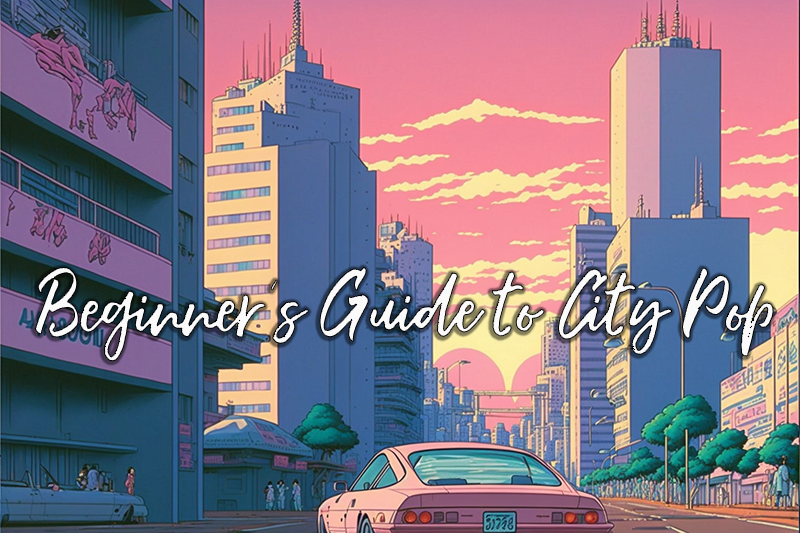Beginner's Guide to Understanding City Pop: Part I
Disclaimer: The blog post below is an exploration of city pop that uses references online and the personal experiences of the author to convey a narrative that may or may not align with the reader’s own experiences or thoughts on the matters discussed. If there is any inaccurate information or anything that needs correcting you can leave a comment below. That being said, please use this information to fuel your own research and development on the subject.
Thank you for reading.
Beginner's Guide to Understanding City
Pop Part I
City Pop. It’s a contentious term at times. What does it really mean? Why should you care? Do you have to know Japanese to really enjoy it? These are all questions that merit at least some entertaining, and entertaining they shall receive. There is a rich cultural history to the music that is still being charted and put together by people in both Japan and overseas. The complete picture is something that is being explored on many levels and is still evolving even today. There has been so much development in City Pop since I started in 2015 that I feel obligated to try and map out everything I’ve learned from my years of curating, DJing, writing, speaking, and living City Pop. From the shabby bars of 70s Tokyo, to the screens of YouTube audiences in the 2010s, and back again to the nightclubs of the 2020s, let’s get into what City Pop really is and where its going. I’ll try my best to write without the use of excessive superfluousness, inordinate exorbitance, whimsical mysticism… and well, you get what I’m saying, I hope.
In the year of our lord, 2023, a Japanese pop star who debuted in 1978 will celebrate 45 years in the music business. This pop star, widely known by the City Pop community is none other than Anri; a finely matured chanteuse that has cranked out bops faster than a rotary sushi bar, and yet every one of her endless hits are memorable, catchy, and can bring even the most cynical internet troll to their knees with her creamy vocals frosted on top of chunky slap basslines, funky brass sections, and sparkling synth cascades. Mostly, her songs are in Japanese, but often you hear a sprinkling of English words that may or may not be decipherable, but always deliciously enjoyable nonetheless. Thematically, her songs often deal with the quintessential topics that City Pop has come to be known by—Endless Summers, Faded Romance, Heartbreak, Farewells, and the twinkling optimism of a country that had attained what seemed like a golden age thanks to its economic miracle. Going into the 90s, when Japan’s economy collapsed, much of City Pop’s appeal was lost, as more grittier genres like Hip Hop and Techno resonated more with the youth of what would become known as the ‘Lost Decades’. These days, however, Anri seems poised to make a dazzling comeback once again.
In recent times other City Pop stars had reached critical success online by way of YouTube and TikTok algorithms. Mariya Takeuchi with her multimillion views on YouTube catapulted her back into the limelight both in her own country and overseas, where her classic song ‘Plastic Love’ would be dubbed as the best pop song of 2018, even though it was recorded in 1984. Mariya’s rise to popularity in the west wasn’t without controversy, however, as Alan Levenson, the photographer who snapped the portrait being used for the YouTube cover art for the song had fought back against Sony and YouTube to get the rights to the iconic image he owned. The video would be taken down from the original account that posted it, a channel called Plastic Lover, to another one simply one named Gun, where it currently lived and sat at around 56 million views before being taken down also. The video would later go on to receive an official video by Warner Music Japan, but didn’t receive much praise due to its generic portrayal of the song. Besides Plastic Love, Mariya Takeuchi had already reached the top status of singers in Japan, and without a shadow of a doubt someone at some point will surely point out to you for the 10th time that she is also married to Tatsuro Yamashita; another one of the biggest stars of City Pop.
Another singer from Japan would also find renewed popularity in the West after Mariya Takeuchi’s Plastic Love waned in popularity after the pandemic hit. Mayonaka no Door/Stay With Me would go on to streak into the top global charts on Spotify and Apple Music, making the beloved singer the next City Pop star to go viral. Thanks to TikTok, Miki Matsubara became the 2nd most widely known City Pop singer amongst non-city pop fans. Considering her incredible voice, compelling songwriting, and generally sweet demeanor, It’s not hard to see why she regained her claim to fame with new, younger audiences. Sadly, this surge in popularity came too late, as she passed away in 2004, never seeing her music reach critical success overseas. While mainly written in Japanese, Mayonaka no Door/Stay With Me’s lyrics are still backed by Matsubara’s raw emotional vocal power, enchanting hooks, and the production chops needed to be as memorable as any song Michael Jackson could have worked on. The staying power of City Pop music is most evident in songs like this, which strike the perfect balance between sounding foreign and yet familiar (to us westerners atleast). City Pop, at its heart is the fusion of the East and West, and this is exemplified in the tragic end and lasting appeal of Miki Matsubara.
So how did a loosely defined Japanese genre with funk, jazz, and pop influences, dating as far back as the 70s, resurface in the late 2010s? For that we have to go back in time, to Japan’s commercialist utopia of mass production. In those days, roughly mid-70s Japan, a post-war economic boom had helped the country gain dominance in many tech and industrial sectors. Many brands that are household names today, like Sony, Toyota, Honda, Mitsubishi, Nintendo, and more would gain a substantial boost and omnipresence during the time. Affordable sophistication was being offered by companies who would become globalist darlings exporting any and every kind of car, product, and technology with top quality in mind. This sudden rise gave way for the creation of more advanced music instruments and audio equipment, including synthesizers that would play a crucial role in the sound of City Pop. Brands like Yamaha, Roland, and Korg were being manufactured in Japan. Beginning in the 1980’s, synthesizers with American brands began to be made in Japan also. Two examples that come to mind are the Fender Rhodes Chroma Polaris and Sequential Circuits Six-track. Also, several hundred of the Sequential Circuits Prophet 600 synths were made in Japan in 1984.
City Pop was pioneered by Eiichi Ohtaki, who had been in a proto-City Pop band called Happy End, that was active betwen 1968 and 1972, and included the brilliant Haruomi Hosono, but later went on to create a solo discography that would closely tie the worlds of Japanese Pop with American Yacht Rock. He would also go on to produce the band Sugar Babe in 1973, which featured the later City Pop trailblazers Tatsuro Yamashita, and Taeko Ohnuki. Sugar Babe’s music was often panned at the time by Japanese critics for sounding too Western, due to drawing inspiration from Western styles like disco, boogie, and RnB elements. At the time, many new styles of Japanese music were being introduced, including genres like Kayo-Kyoku, Idol, and Prog Rock, among others. Western influences were trickling in and inspiring many prominent artists, like Hideki Saijo, who were wanting to make their music more appealing to western audiences by including English in their lyrics, using Western pop music’s structure, and using American sound engineers and musicians. With the rapidly expanding Japanese corporate empire, they must have thought that soon enough Western audiences would be listening to Japanese music, unfortunately that prediction was off by about nearly half a century.
Once Sugar Babe broke up in 1976, Tatsuro Yamashita would go on to create a solo discography that now defines what we have come to recognize as the essential ‘City Pop’ sound, with classic albums like Spacy, Ride on Time, and For You. By taking Western pop and disco song structure and adding to it the Japanese sensibilities for melody, chord, multi-layered instrumentalism, and elements from a variety of genres fused into a shining new style that needed only to be bound by a similarly shared feeling; City Pop was born. The embodiment of Japan’s newly minted status as a global superpower, along with the rising towers of cosmopolitan living created the mentality to indulge in the decadence of the moment, and City Pop was the soundtrack to this burgeoning new Japanese socialite class. Many artists would adopt the City Pop sound in the 70s and take the genre into different directions but still tied together by the western sounding template that Sugar Babe championed. The Japanese music scene, economy, and global influence would soon be transformed again going into the 80s…
To be continued…
AUTHOR
Van Paugam is an Internationally-Acclaimed DJ and leading figure specializing in 70s and 80s Japanese Music, dubbed City Pop. He has organized and hosted over 100 events dedicated to the style, and actively promotes Japanese culture while on the board of the Japanese Arts Foundation of Chicago. He has been featured on CNN, NHK, and many other publications for his dedication to City Pop. Van is credited with being the first person to begin popularizing City Pop online through his mixes on YouTube in 2016, and subsequently through live events. Learn More…




![Tomoko Aran - Fuyu Kukan [2024 Reissue]](https://images.squarespace-cdn.com/content/v1/5bd7707c11f7847c45b4b9dd/1689118417870-VK5509S75OAQ8XLR9TEG/ab67616d0000b273138d0143d948a5314d1aea19.jpg)
![Kingo Hamada - Midnight Cruisin' [Reissue]](https://images.squarespace-cdn.com/content/v1/5bd7707c11f7847c45b4b9dd/70b59ba1-850e-4a6d-a827-34e221a172bf/WQJL-159.jpg)
![Mioko Yamaguchi - Tsukihime Moonlight [Reissue]](https://images.squarespace-cdn.com/content/v1/5bd7707c11f7847c45b4b9dd/1688493110328-NTAQQVZ245PY48X3I6H4/MHJL-278.jpg)
![Yurie Kokubu - Steps [Reissue]](https://images.squarespace-cdn.com/content/v1/5bd7707c11f7847c45b4b9dd/1688492253619-240QYD9A83G0GLRKQ08U/MHJL-282.jpg)
![Anri - Natsu Ban [New EP]](https://images.squarespace-cdn.com/content/v1/5bd7707c11f7847c45b4b9dd/1687905964336-9PV1QDIP2YNMEKDHS14R/Screenshot+2023-06-27+174101.png)
![Anri - COOOL [Reissue]](https://images.squarespace-cdn.com/content/v1/5bd7707c11f7847c45b4b9dd/1682575601801-C2BEL9RM2RUHJS9OBSL1/ab67616d0000b27339b329eaf36f09af3c2356f4.jpg)
![Anri - Timely!! [Reissue]](https://images.squarespace-cdn.com/content/v1/5bd7707c11f7847c45b4b9dd/1682575330424-OPVMZCJ0GUYHW6P0X5UT/R-5126669-1638115528-6607.jpg)
![Anri - Heaven Beach [Reissue]](https://images.squarespace-cdn.com/content/v1/5bd7707c11f7847c45b4b9dd/1682574623734-QWHWV5NQSM71KRKK8K6G/R-4777778-1618165602-9892.jpg)
![Anri - Bi Ki Ni [Reissue]](https://images.squarespace-cdn.com/content/v1/5bd7707c11f7847c45b4b9dd/1682575025867-NBUJHCR4R997RWTHJ71K/R-6161494-1640871595-6430.jpg)
![Miki Matsubara - Pocket Park [Reissue]](https://images.squarespace-cdn.com/content/v1/5bd7707c11f7847c45b4b9dd/1682919786676-RDDRQMQ80QIJP8SD61JS/IMG_8996.jpeg)
![Miki Matsubara - Who Are You [Reissue]](https://images.squarespace-cdn.com/content/v1/5bd7707c11f7847c45b4b9dd/1682919471387-FEXQME3R87Z0GGN8OM30/IMG_8995.jpeg)
![Taeko Ohnuki - Mignonne [Reissue]](https://images.squarespace-cdn.com/content/v1/5bd7707c11f7847c45b4b9dd/1677631540050-MB8QQ48ZP5NKH0P9F61Z/31qFb8S%2BGKL.jpg)
![Tatsuro Yamashita - Go Ahead [Reissue]](https://images.squarespace-cdn.com/content/v1/5bd7707c11f7847c45b4b9dd/1677630549318-VK4691LKREAD8ILYCDTG/BVJL-93.jpg)
![Yurie Kokubu - Relief 72 Hours [Reissue]](https://images.squarespace-cdn.com/content/v1/5bd7707c11f7847c45b4b9dd/1677629440079-6RWRK2ZWERH37N9Y30KE/%E5%9B%BD%E5%88%86%E5%8F%8B%E9%87%8C%E6%81%B5-yurie-kokubu-relief-72-hours-Cover-Art.jpg)
![Momoko Kikuchi - Tropic of Capricorn [Reissue]](https://images.squarespace-cdn.com/content/v1/5bd7707c11f7847c45b4b9dd/1674797802522-6G0J6KOSVEHW51M7EIWH/Tropic+of+Capricorn.jpg)
![Momoko Kikuchi - Ocean Side [Reissue]](https://images.squarespace-cdn.com/content/v1/5bd7707c11f7847c45b4b9dd/1674798147688-5U1MW4DHPF1JJCB97Q5Z/Ocean+Side.jpg)
![Momoko Kikuchi - Escape From Dimension [Reissue]](https://images.squarespace-cdn.com/content/v1/5bd7707c11f7847c45b4b9dd/1674797753044-X7EKMKXREYA8ZSZD1DAA/escape+from+dimension.jpg)
![Momoko Kikuchi - Adventure [Reissue]](https://images.squarespace-cdn.com/content/v1/5bd7707c11f7847c45b4b9dd/1674797693224-VN0M90A8BM9LPTYWBSB5/Adventure.jpg)
![Hitomi Tohyama - Imagination [Reissue]](https://images.squarespace-cdn.com/content/v1/5bd7707c11f7847c45b4b9dd/1674797015412-B47AFOTZHWA2CO5BUMAA/Imagination.jpg)
![Hitomi Tohyama - Sexy Robot [Reissue]](https://images.squarespace-cdn.com/content/v1/5bd7707c11f7847c45b4b9dd/1674714815791-4KT0NM9S4ED18FLQKHKC/sexy+robot.jpg)
![Tatsuro Yamashita - Greatest Hits [Reissue]](https://images.squarespace-cdn.com/content/v1/5bd7707c11f7847c45b4b9dd/1674713862344-KZQM2GX3TF0Y8XODXT1P/R-3282359-1533691121-1914.jpg)
![Tatsuro Yamashita - For You [Re-Press]](https://images.squarespace-cdn.com/content/v1/5bd7707c11f7847c45b4b9dd/1674713532165-3F6PUTT1U16F9RKFDKCQ/R-2179374-1576817857-6649.jpg)
![Tatsuro Yamashita - Ride On Time [Reissue]](https://images.squarespace-cdn.com/content/v1/5bd7707c11f7847c45b4b9dd/1674713298310-CX7AAYGDCK9VRC09V8F7/R-3282392-1341996717-7068.jpg)
![Tatsuro Yamashita - Moonglow [Reissue]](https://images.squarespace-cdn.com/content/v1/5bd7707c11f7847c45b4b9dd/1674712985847-GAAP57FYG3W34MT0KX6Z/R-2063296-1594137375-1639.jpg)
![Tatsuro Yamashita - It's A Poppin' Time [Re-Press]](https://images.squarespace-cdn.com/content/v1/5bd7707c11f7847c45b4b9dd/1674711577552-6OG8AHZTL0A0VMOFACE6/R-5223079-1601375868-4345.jpg)
![Tatsuro Yamashita - Spacy [Reissue]](https://images.squarespace-cdn.com/content/v1/5bd7707c11f7847c45b4b9dd/1674711439752-GP5PA47QCYGU14Q1F8I9/R-1006498-1322902455.jpg)
![Tatsuro Yamashita - Circus Town [Reissue]](https://images.squarespace-cdn.com/content/v1/5bd7707c11f7847c45b4b9dd/1674710622935-WAUHPKKQAQSUPFH8NC0G/BVJL-95.jpg)
